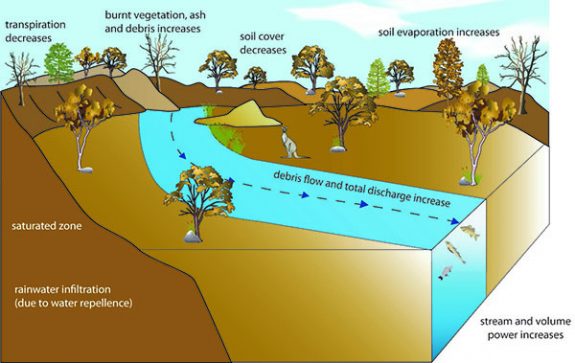Drinking water under threat from bushfire

Edith Cowan University Media Release
Rainfall after fire brings immediate relief but the environmental effects can sometimes be as significant as the fire itself.
Edith Cowan University (ECU) environmental experts Professor Pierre Horwitz and Dr Dave Blake are investigating the long-term impacts of water supply contamination after fire has swept through a region.
Over the next four years in collaboration with the Water Corporation, the ECU researchers will lead a comprehensive investigation of forested water catchments in the Perth Hills from Mundaring Weir to Collie.
Dr Blake said that water quality is not at the forefront of people’s minds during the management of a fire, but this could result in problems with community’s water supply for years.
“After vegetation cover is burned, and the soil is scorched, what’s left is the concentrated and chemically transformed ash, exposed and vulnerable to wind and water erosion. Heavy rainfall will wash this ash, topsoil and incompletely burned vegetation into streams and water reservoirs,” he said.
“All of this eroded matter is accompanied by dissolved organic compounds, carcinogens and heavy metals from the soil that are exposed and concentrated after a fire.
“Water treatment plants aren’t set up to deal with this sort of contamination and can suspend water supply if faced with this sort of contamination.”
Lessons from Yarloop
The ECU team completed an initial study in the Yarloop region in South West WA after the devastating bushfire destroyed more than 69,000 hectares of land in 2016.
Professor Horwitz said water was one of the big concerns of the Yarloop community after the megafire.
“After the danger had passed Yarloop residents were looking for immediate guidance on how to protect their water assets from the effects of the fire. So, having a better understanding of the long-term consequences for water would be a powerful tool to help to guide fire management protocol,” he said.
Investigations in Yarloop helped researchers map erosion hotspots and variable fire risk to determine potential contamination risks around water catchments.
“We found that in this region erosion was particularly harsh on steep terrain where the fire had been very severe,” Dr Blake said.
“Now we want to expand our work to a wider region, and consider land after fires of different burn intensities, like prescribed burns and wildfires, and wherever possible, collect pre-fire and fire history information as well.”
Professor Horwitz said the research would lead to tools for environmental managers to apply in their areas to prevent post-fire erosion and subsequent water contamination.
“By factoring in the land topography, fire severity and rain intensity we can identify how long it takes burnt material to make its way into reservoirs used for water supply, then perhaps we can prevent the contamination altogether,” he said.
“Understanding why some areas are particularly vulnerable will tell us where to go, and when and how, to stop particular sources of contamination from soil erosion after a fire.”
Assessment of post-wildfire erosion risk and effects on water quality in south-western Australia and can be read here in the International Journal of Wildland Fire.
Like what we do at The AIMN?
You’ll like it even more knowing that your donation will help us to keep up the good fight.
Chuck in a few bucks and see just how far it goes!










2 comments
Login here Register here-
ajogrady
-
New England Cocky
Return to home pageNo mention of the chemicals in the fire retardants that were dropped all over. These chemicals must have an effect on water quality.
The greatest risk to drinking water supply in the Armidale Regional Council (ARC) local government area is the ARC policy of allowing Costas Guyra Tomato Farm almost unlimited access to the Malpas Dam drinking water supply for Armidale during the worst drought in living memory.
The NSW Nazional$ used taxpayer revenues to fund a $13 MILLION pipeline from Malpas Dam directly into the Tomato Farm and ARC ‘sold’ water to the Tomato Farm to grow profits for the about 50% owned Canadian shareholders. In contrast, the Coffs Harbour Council declined to supply Costas blueberry farms access to Coffs Harbour town water.
The ASX Initial Public Offering for Costas about five (5) years ago valued the company at about $750 MILLION. So if you purchase about 50% of a horticultural enterprise in a drought prone area it is reasonable to expect to have to build your own water supply infrastructure, just like every other agricultural enterprise in the district.
There is much skullduggery occurring in ARC and also in New England where international mining corporations are encouraging dam construction at public expense so that those miners may expand the coal mines at Gunnedah using water piped in from the eastern fall at Walcha.
Can you guess which political party has members chairing an international coal corporation? Can you guess which political party is ignoring the best interest of Australian voters in all three levels of government? Do you think there may be an aspiring politician working to gain financial donations for an election run into a seat in Parliament?